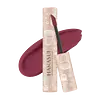What's inside
What's inside
 Key Ingredients
Key Ingredients

 Benefits
Benefits

 Concerns
Concerns

 Ingredients Side-by-side
Ingredients Side-by-side

Isododecane
EmollientCyclopentasiloxane
EmollientAluminum Starch Octenylsuccinate
AbsorbentKaolin
AbrasiveMicrocrystalline Wax
Emulsion StabilisingPolyglyceryl-2 Triisostearate
EmulsifyingTrimethylsiloxysilicate
EmollientDisteardimonium Hectorite
StabilisingPropylene Carbonate
SolventDimethicone/Vinyl Dimethicone Crosspolymer
Skin ConditioningPhenoxyethanol
PreservativeParfum
MaskingOlea Europaea Husk Oil
Skin ConditioningTocopheryl Acetate
AntioxidantAluminum Hydroxide
EmollientIsononyl Isononanoate
EmollientIsopropyl Myristate
EmollientIsopropyl Titanium Triisostearate
EmollientPolyhydroxystearic Acid
EmulsifyingStearalkonium Hectorite
Gel FormingIsododecane, Cyclopentasiloxane, Aluminum Starch Octenylsuccinate, Kaolin, Microcrystalline Wax, Polyglyceryl-2 Triisostearate, Trimethylsiloxysilicate, Disteardimonium Hectorite, Propylene Carbonate, Dimethicone/Vinyl Dimethicone Crosspolymer, Phenoxyethanol, Parfum, Olea Europaea Husk Oil, Tocopheryl Acetate, Aluminum Hydroxide, Isononyl Isononanoate, Isopropyl Myristate, Isopropyl Titanium Triisostearate, Polyhydroxystearic Acid, Stearalkonium Hectorite
Dimethicone
EmollientDimethicone/Vinyl Dimethicone Crosspolymer
Skin ConditioningWater
Skin ConditioningPolyglyceryl-2 Triisostearate
EmulsifyingCetyl PEG/PPG-10/1 Dimethicone
EmulsifyingIsododecane
EmollientButylene Glycol
HumectantVinyl Dimethicone/Methicone Silsesquioxane Crosspolymer
CI 77491
Cosmetic ColorantDimethicone Crosspolymer
Emulsion StabilisingCI 15985
Cosmetic ColorantCI 77891
Cosmetic ColorantCI 15850
Cosmetic ColorantCI 19140
Cosmetic ColorantPEG-60 Hydrogenated Castor Oil
EmulsifyingCeramide AP
Skin Conditioning1,2-Hexanediol
Skin ConditioningVp/Hexadecene Copolymer
Disteardimonium Hectorite
StabilisingCI 77499
Cosmetic ColorantPhenoxyethanol
PreservativePropylene Carbonate
SolventParfum
MaskingCI 45410
Cosmetic ColorantAluminum Hydroxide
EmollientCI 42090
Cosmetic ColorantDimethicone, Dimethicone/Vinyl Dimethicone Crosspolymer, Water, Polyglyceryl-2 Triisostearate, Cetyl PEG/PPG-10/1 Dimethicone, Isododecane, Butylene Glycol, Vinyl Dimethicone/Methicone Silsesquioxane Crosspolymer, CI 77491, Dimethicone Crosspolymer, CI 15985, CI 77891, CI 15850, CI 19140, PEG-60 Hydrogenated Castor Oil, Ceramide AP, 1,2-Hexanediol, Vp/Hexadecene Copolymer, Disteardimonium Hectorite, CI 77499, Phenoxyethanol, Propylene Carbonate, Parfum, CI 45410, Aluminum Hydroxide, CI 42090
 Reviews
Reviews

Ingredients Explained
These ingredients are found in both products.
Ingredients higher up in an ingredient list are typically present in a larger amount.
Aluminum Hydroxide is a form of aluminum. It can be naturally found in nature as the mineral gibbsite. In cosmetics, Aluminum Hydroxide is used as a colorant, pH adjuster, and absorbent.
As a colorant, Aluminum Hydroxide may add opacity, or reduce the transparency. Aluminum hydroxide is contains both basic and acidic properties.
According to manufacturers, this ingredient is an emollient and humectant. This means it helps hydrate the skin.
In medicine, this ingredient is used to help relieve heartburn and help heal ulcers.
There is currently no credible scientific evidence linking aluminum hydroxide in cosmetics to increased cancer risk.
Major health organizations allow the use of aluminum hydroxide in personal care products and have not flagged it as a carcinogenic risk at typical usage levels.
Learn more about Aluminum HydroxideThis ingredient is a silicone used to improve the texture of products and absorb oil. It does not get absorbed into the skin.
Like other silicones, Dimethicone/Vinyl Dimethicone Crosspolymer helps condition the skin by creating a barrier. In this sense, it can act as an emollient and trap moisture in.
This ingredient is a type of elastomer.
Learn more about Dimethicone/Vinyl Dimethicone CrosspolymerDisteardimonium Hectorite comes from the clay mineral named hectorite. It is used to add thickness to a product.
It can also help stabilize a product by helping to disperse other ingredients.
Hectorite is a rare, white clay mineral.
Learn more about Disteardimonium HectoriteIsododecane is a fragrance, emollient, and solvent.
As an emollient, it helps your skin stay soft and hydrated. Emollients help trap moisture into your skin.
Isododecane's role as a solvent makes it a great texture enhancer. It spreads smoothly on skin and does not leave a sticky feeling behind. Isododecane also helps prevent color transfer in makeup products.
Isododecane is not absorbed into skin.
Learn more about IsododecaneParfum is a catch-all term for an ingredient or more that is used to give a scent to products.
Also called "fragrance", this ingredient can be a blend of hundreds of chemicals or plant oils. This means every product with "fragrance" or "parfum" in the ingredients list is a different mixture.
For instance, Habanolide is a proprietary trade name for a specific aroma chemical. When used as a fragrance ingredient in cosmetics, most aroma chemicals fall under the broad labeling category of “FRAGRANCE” or “PARFUM” according to EU and US regulations.
The term 'parfum' or 'fragrance' is not regulated in many countries. In many cases, it is up to the brand to define this term.
For instance, many brands choose to label themselves as "fragrance-free" because they are not using synthetic fragrances. However, their products may still contain ingredients such as essential oils that are considered a fragrance by INCI standards.
One example is Calendula flower extract. Calendula is an essential oil that still imparts a scent or 'fragrance'.
Depending on the blend, the ingredients in the mixture can cause allergies and sensitivities on the skin. Some ingredients that are known EU allergens include linalool and citronellol.
Parfum can also be used to mask or cover an unpleasant scent.
The bottom line is: not all fragrances/parfum/ingredients are created equally. If you are worried about fragrances, we recommend taking a closer look at an ingredient. And of course, we always recommend speaking with a professional.
Learn more about ParfumPhenoxyethanol is a preservative that has germicide, antimicrobial, and aromatic properties. Studies show that phenoxyethanol can prevent microbial growth. By itself, it has a scent that is similar to that of a rose.
It's often used in formulations along with Caprylyl Glycol to preserve the shelf life of products.
This ingredient is a form of glycerin with emulsifying and emollient properties.
As an emulsifier, this ingredient helps keep products together while adding a thick texture. The manufacturer states this ingredient has emollient properties. Emollients help keep the skin hydrated by trapping moisture in.
Polyglyceryl-2 Triisostearate is created by reacting diglycerin and isostearic acid. Due to the isostearic acid base, it may not be safe for Malassezia or fungal acne.
Learn more about Polyglyceryl-2 TriisostearateThis ingredient is a solvent. It helps dissolve active ingredients and alter the texture of products.
Propylene Carbonate is commonly used in makeup and with clay, such as montmorillonite or bentonite.
Studies show this ingredient to be safe for cosmetics. When it is undiluted, it can cause skin irritation. (It is always diluted in skincare and makeup). This ingredient is water-soluble.
Propylene Carbonate is created from propylene glycol and carbonic acid.
Learn more about Propylene Carbonate